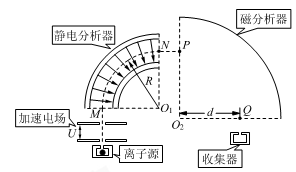(10分)有一种质谱仪的工作原理图如图所示。静电分析器是四分之一圆弧的管腔,内有沿圆弧半径方向指向圆心O1的电场,且与圆心O1等距各点的电场强度大小相等。磁分析器中以O2为圆心、圆心角为90°的扇形区域内,分布着方向垂直于纸面的匀强磁场,其左边界与静电分析器的右边界平行。由离子源发出一个质量为m、电荷量为q的正离子(初速度为零,重力不计),经加速电场加速后,从M点沿垂直于该点的电场方向进入静电分析器,在静电分析器中,离子沿半径为R的四分之一圆弧做匀速圆周运动,并从N点射出静电分析器。而后离子由P点射入磁分析器中,最后离子沿垂直于磁分析器下边界的方向从Q点射出,并进入收集器。已知加速电场的电压为U,磁分析器中磁场的磁感应强度大小为B。

(1)请判断磁分析器中磁场的方向;
(2)求静电分析器中离子运动轨迹处电场强度E的大小;
(3)求磁分析器中Q点与圆心O2的距离d。
(1)垂直纸面向外(2) (3)
(3)
题目分析:(1)带正电的粒子进磁场的速度水平向右,要从下边界Q射出,P点的洛伦兹力必须竖直向下,根据洛伦兹力左手定则判断磁场方向垂直纸面向外。
(2)设离子进入静电分析器时的速度为v,离子在加速电场中加速,
根据动能定理 有 ①
①
离子在静电分析器中做匀速圆周运动,指向圆心O1的电场力为向心力,有 ②
②
由①②解得 ③
③
(3)离子在磁分析器中做匀速圆周运动,圆心为O2,根据牛顿第二定律 有
 ④
④
由题意可知,水平向右进入磁场,竖直向下离开磁场,根据几何关系可得圆周运动的轨道半径 ⑤
⑤
由①④⑤式解得 ⑥
⑥
